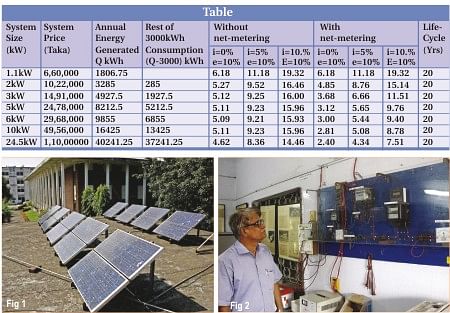Grid-connected solar power shines at DU campus

Fig 1: Rooftop grid connected photovoltaic system at the Renewable Energy Research Centre (RERC), University of Dhaka.
Fig 2: The author looks at the wiring diagram of the system.Photo: Anisur Rahman
Would you like to be a proud owner of an electric power generator? Would you like to produce clean and pollution-free green power without fuel at your home? Would you like to earn money by feeding your surplus power to the national grid from this system?
Yes, you too can have it, if you have a bright sunny roof-top or a compound at your home.
Our country is a low-economy country and per-capita energy consumption is one of the lowest in the world. The conventional resources in Bangladesh are inadequate for supplying the energy needs of our economy.
The only dependable indigenous gas, which is the major source of primary energy in the country, is used mainly for the production of electricity and fertilizer. According to expert's opinion our gas reserves will be exhausted within 2020. Therefore, we must find alternative sources of energy to maintain the energy supply of our country.
Renewable energy, which is environment friendly, inexhaustible and sustainable, can be considered as one of the important alternatives and it can play a significant role in the energy scene of the country. The most viable sources of renewable energy, in the country are solar, wind, biomass, and biogas. At present contribution of energy from solar and wind is only 0.1%.
It is encouraging that private organisations and NGOs have come forward by taking different projects to utilize solar devices and to provide photovoltaic (PV) electricity to villages in Bangladesh where national grid line has not yet reached.
Today, Solar Home Systems (SHS) are gradually becoming popular in the rural areas in Bangladesh. But in cities, where the power supply is insufficient, fluctuating and failure is a regular event, grid-connected PV system can be a good power source if installed on the roof-tops of the building. In the remote areas if the supply of power in the existing grid is needed to be increased to keep pace with the increasing demand, this system can be a good solution as the system is modular and easy to install.
The power produced by the roof-top grid-connected PV system can be used to supply local loads, with the excess energy fed into the local grid for use by other customers. At night, the local loads are simply supplied by the grid power. If the PV system is large enough, it can supply more energy into the grid than is used by local loads. Instead of receiving a bill every month from the utility supply office, the owner of the system would then be able to earn money by generating surplus electricity.
Grid-connected PV power systems are being installed in cities in different countries of the world. Government policies are being framed to encourage and popularize this system by providing necessary regulations and incentives in many developed and developing countries. From the gradual decrease of prices and increased rate of installation of the systems in the cities all over the world it can be easily comprehended that this system will become an important source of electricity in a very short time in the urban areas.
Roof-top grid-connected PV systems are also being installed in our neighbouring countries like India, Thailand and Indonesia. The future of PV-grid electricity in Bangladesh is also very bright as we have bright sun light throughout the year.
Realizing the significant potential of this technology a model of 1.1kW rooftop grid connected photovoltaic system has been developed and successfully installed (Fig.1) at the roof-top of Renewable Energy Research Centre (RERC), Dhaka University under the financial assistance of the Ministry of Science and Information & Communication Technology. Wiring diagram of the system is shown in Fig.2.
The installed system was run for several days in different weather conditions and the performance was found to be quite satisfactory.
To understand the financial viability of the system, a preliminary economic analysis of the 1.1kW roof-top grid-connected PV systems along with various sizes (Table) has been made. In the analysis standard methods of economics have been utilized considering various factors, viz., capital cost, life-cycle of the system, interest rate, inflation rate, operation and maintenance cost with and without net metering benefit. The above estimation was made by considering an average demand of 3000kWh for a four-member family. It is also seen from the table that a system of 2kW power for a single house-hold can produce surplus energy that can be fed to the national grid.
For 0% to 10% interest rates and 10% depreciation the unit-price of electricity with and without net-metering facilities will be respectively Tk.4.85-15.14 and Tk.4.85-15.14 only. As the system size becomes larger, the unit-price with net-metering decreases rapidly. The unit-price of electricity for the 1.1kW system at the above interest rates and depreciation is from 6.18 to 19.32 taka only.
At present Bangladesh is going through severe electricity crisis. In this situation, this system can be a good alternative small-scale power source on the roof-top of the building in the cities that does not require any fuel. It is observed from the preliminary economic analysis that the system would be financially feasible if subsidy is given and net-metering regulation is framed by the government. Moreover, the impact of the system on the environment friendly issue should be considered as the system does not pollute the environment at all. From the performance study it is also found that the system works efficiently. For emergency power supply of multistoried building Rajuk should frame some incentive based building-acts to encourage the integration of solar PV system as a part of future design and implementation.

 For all latest news, follow The Daily Star's Google News channel.
For all latest news, follow The Daily Star's Google News channel. 



Comments